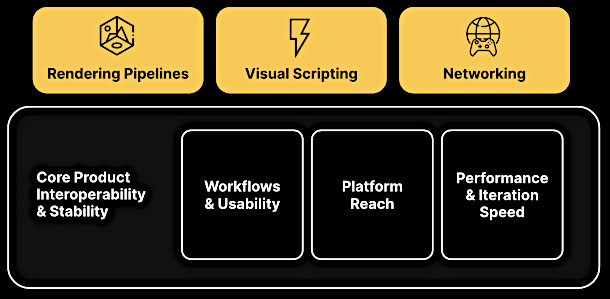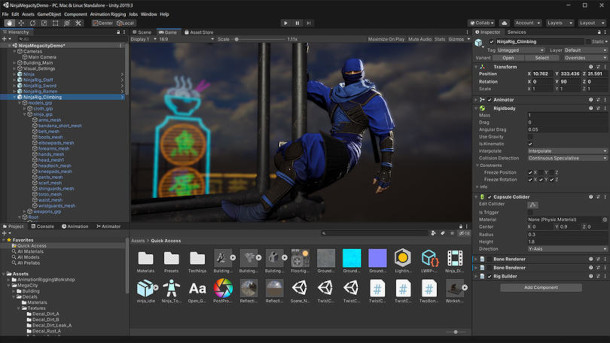Unity reveals 2021 roadmap

Unity Technologies has posted its product roadmap for 2021, spanning the Unity 2020 LTS, Unity 2021.1 and Unity 2021.2 releases of the game engine and real-time graphics development platform.
The firm’s blog post focuses on broad themes rather than specific features, but notes that the rendering pipeline – and particularly, bringing the URP closer to feature parity with the HDRP – will be a key focus.
Other changes relevant to games artists include a new spline API, due to be rolled out in procedural camera systgem Cinemachine, and performance updates to the 2D and physics systems.
In separate news, the firm has made the Unity Editor’s dark UI theme, previously only available with paid subscriptions, available to users with free subscriptions, in both Unity 2019 LTS and Unity 2020.1.
More focus on fixing old features as well as developing new ones
A notable feature of the roadmap is the emphasis that Unity is now placing on testing features, rather than simply developing them.
In January, the firm announced that it was switching from three “tech stream” releases per year – those that introduce new functionality – to two per year, to give beta testers time to “get deeper into them”.
That now seems to have been codified as ‘six months of new features, six of fixes’.
In the roadmap, the feature release cycle is listed as March to October 2021, presumably leaving the rest of the year available to focus on the annual Long Term Support (LTS) releases.
Unity describes its new focus as “about giving you production-ready features”, rather than simply rolling new functionality out in preview, and leaving users to decide when it is performant enough to adopt in production.
According to the blog post, “We consider a feature production-ready if it fully meets your needs, is fully supported from release, and has timely bug-fixing, improvements, and a clear roadmap.”
Unity 2020 LTS: support for PlayStation 5, Xbox Series X and Apple Silicon
The first release listed on the roadmap is Unity 2020 LTS, which provides “stabilised” versions of features introduced in Unity 2020.1 last month, and in the upcoming Unity 2020.2.
Specific commitments include “reorderable arrays and lists in the Inspector, improved Inspector copy/paste [and] the ability to mark an object as ‘default parent’ in the Hierarchy”.
Unity 2020 LTS will also support the main new hardware platforms due for release this year: next-gen game consoles PlayStation 5 and Xbox Series X, and Apple Silicon Macs.
Other than that, beyond a general commitment to “iteration speed” and “performance improvements”, there isn’t a lot of detail, beyond the fact that the release is scheduled for “Q1 2021”.
That would bring it forward a few months from the last two LTS releases, which shipped in May and June.

Unity 2021.1 and Unity 2021.2: greater parity between the render pipelines, new spline API
For the 2021 release cycle – the actual version numbers aren’t given, but presumably Unity 2021.1 and Unity 2021.2 – Unity describes its focus as “graphics, multiplayer networking and visual scripting”.
For graphics, the focus is on finally bringing Unity’s Universal Render Pipeline (URP) up to feature parity with the High Definition Render Pipeline (HDRP), three years after they were released in preview in Unity 2018.1.
The introduction of separate pipelines targeted at mobile devices and at desktop and console hardware enabled Unity to introduce new high-end graphics features, in evidence in the firm’s recent tech demos, but broke with the ‘write once, run anywhere’ philosophy previously seen as a selling point for the engine.
In the comments to the blog post, Unity describes feature parity as “our current focus”, although it stops short of guaranteeing that it will happen in 2021.
Other changes directly relevant to games artists include a new “public generic spline API” that will enable users to “create and edit different types of 3D splines in the Unity Editor”.
The first feature to make use of the new API will be Cinemachine, Unity’s procedural camera system.
Changes to the other art tools will focus on improving existing features: for 2D graphics, the focus is on “workflows and rendering performance”, for physics, it’s “stability”, and for UI authoring, on bringing the new UI Toolkit out of preview.
Also planned: integrated visual scripting, better tools for developing multiplayer games
Other changes scheduled for 2021 include the integration of Bolt visual scripting system into the Unity Editor. Bolt, which Unity acquired from original developer Ludiq in 2019, is currently available as a free add-on.
Unity also plans to expand its capabilities for multiplayer games, promising “a stable and supported netcode foundation” and “a significant investment in tools, docs and samples to make it easier to get started”.
Enough of next year. What’s coming up in Unity 2020.2?
One thing that the blog post doesn’t cover is the remaining new features due in Unity this year.
Changes due in Unity 2020.2 include updates to global illumination, shader pre-processing, particle effects, and to level prototyping system ProBuilder.
However, at the time of writing, the details are only available by trawling through the release notes for the current alpha build, or through the corresponding section of Unity’s forums.
The only thing listed for Unity 2020.2 in the public roadmap is support for theming in UI Toolkit.
In the comments to its blog post, Unity says that it is “aware of the discrepancies” between the roadmap and the release notes, and that it is “very much on the radar to get addressed”.

A bonus for users with Personal subscription: the dark UI theme is now free to all
And in separate news, Unity has just addressed a longstanding gripe for users with free Personal subscriptions to the software.
As of yesterday’s 2020.1.2f1 and Unity 2019.4.8fl updates, the industry-standard dark UI theme, previously only available with paid plans, is now available to all Unity users.
Pricing and system requirements
Unity 2020.2 is currently available in public alpha. Unity 2020 LTS is scheduled for release in “Q1 2020”. Unity Technologies hasn’t announced release dates for Unity 2021.1 and Unity 2021.2.
The current stable release, Unity 2020.1, is available for Windows 7+, Ubuntu 16.04/18.04 and CentOS 7 Linux, and macOS 10.12+.
The software is available on a rental-only basis: free Personal subscriptions have a non-removable splash screen and can be used by anyone with revenue of up to $100,000/year.
Plus and Pro subscriptions cost $40/month and $150/month for an annual subscription paid monthly.
Read more about the Unity 2021 product roadmap Unity Technologies’ blog
